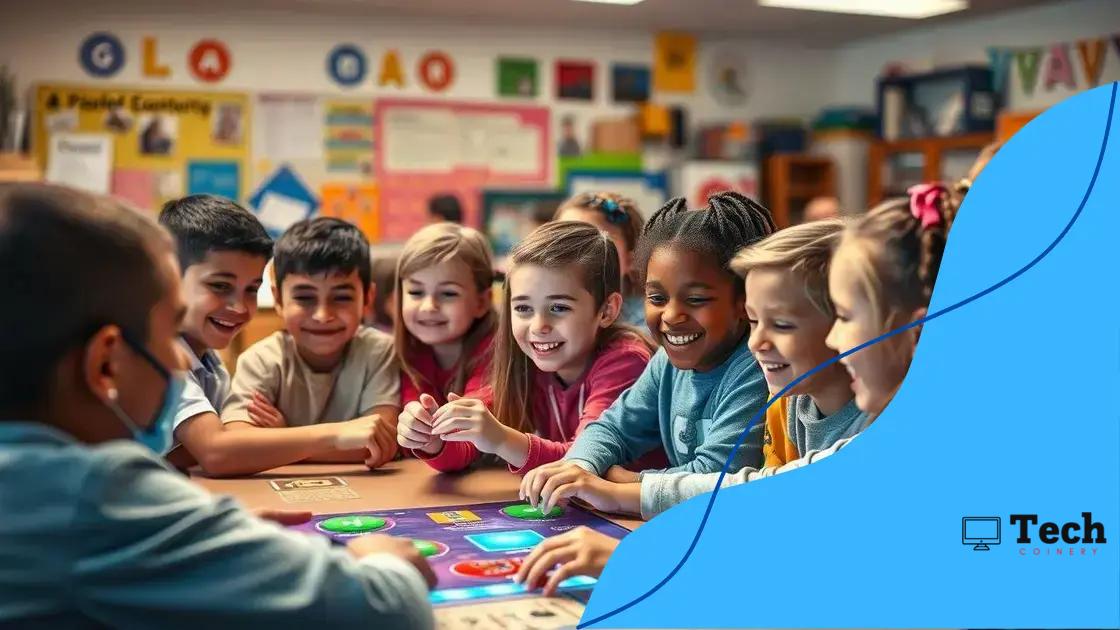Gamification in classrooms: engaging students through play

Gamification in classrooms enhances student engagement and motivation by integrating game elements such as points, badges, and challenges, making learning more interactive and effective.
Gamification in classrooms is increasingly gaining attention as a powerful tool to engage students. By incorporating game-like elements into lessons, educators can make learning more exhilarating and interactive. What might this look like in practice?
Understanding gamification and its relevance
Understanding gamification and its relevance is essential for modern educators. It integrates game mechanics into classroom activities to boost student motivation and engagement. This method encourages learning through competition, challenges, and rewards, transforming the classroom experience.
The Basics of Gamification
At its core, gamification involves applying game design elements in non-game contexts. Educators use points, badges, and leaderboards to create a fun and interactive environment. These elements can help students feel a sense of accomplishment and drive.
Why Gamification Matters
The importance of gamification cannot be overstated. It addresses the needs of diverse learners and fosters a culture of collaboration. Here are a few key benefits:
- Increases student engagement and participation.
- Encourages a growth mindset through challenges.
- Promotes teamwork and interpersonal skills.
Many students respond positively to gamification, as it allows them to track their progress. When they see their achievements displayed, their motivation levels rise. Moreover, it helps in building critical thinking and problem-solving skills by presenting challenges in a game-like format.
As educators explore how to implement gamification effectively, they should consider the specific needs of their students. Tailoring game elements to fit various learning styles can enhance the learning experience for everyone. While gamification can be powerful, it’s essential to strike the right balance between education and entertainment.
Key benefits of using gamification
The key benefits of using gamification in the classroom extend beyond making learning fun. By incorporating game elements into lessons, teachers can create an interactive environment that enhances student motivation and achievement. When students are engaged through gameplay, they feel more connected to the material.
Enhanced Engagement
One of the main advantages of gamification is increased engagement. Students often show higher levels of interest when lessons feel like games. This leads to greater participation and attentiveness in class, which ultimately promotes a deeper understanding of the subject.
Motivation Boost
Gamification also provides a significant boost in motivation for students. When they earn points, badges, or rewards for completing tasks, it creates a sense of accomplishment that encourages them to strive harder. This motivation can lead to better academic performance.
- Increases willingness to tackle challenging content.
- Encourages a positive attitude toward learning.
- Fosters a competitive spirit that drives improvement.
Another key benefit includes the development of critical thinking skills. With game-like challenges, students learn to solve problems creatively and think strategically. As they navigate through various levels or tasks, they enhance their analytical abilities.
Additionally, gamification supports collaboration among students. Group activities and competitions can build teamwork skills, as students learn to communicate and work together effectively. This social interaction can lead to a supportive classroom culture.
Effective strategies for gamifying lessons

Implementing effective strategies for gamifying lessons can transform the educational experience for students. By utilizing game mechanics, teachers can create a dynamic learning environment that motivates and engages students. Here are some effective strategies to consider.
Incorporate Game Elements
One primary strategy is to incorporate game elements such as points, badges, and leaderboards. These elements can foster competition and encourage students to strive for achievement. For instance, awarding points for participation or completing tasks can make learning feel more rewarding.
Create Meaningful Challenges
Another strategy is to design meaningful challenges and quests that align with learning objectives. Gamifying lessons should not just focus on entertainment; challenges must be academically enriching. These challenges can take various forms:
- Group competitions that require critical thinking.
- Individual quests that promote exploration of topics.
- Timed challenges that encourage quick problem-solving.
Using storytelling can also enhance the experience. Create a narrative that students can connect with while working through the lessons. This approach can make the learning process more immersive and relatable. A storyline can provide context and give students a reason to engage genuinely with the material.
In addition to these techniques, integrating technology—like game-based learning platforms—can greatly enhance gamification. These platforms provide ready-made games that align with educational goals while making learning accessible and interactive. They can supplement traditional lessons and provide immediate feedback to students, which is crucial for their growth.
Examples of successful gamification in schools
Examples of successful gamification in schools illustrate how game elements can enhance learning experiences. By incorporating game-based activities, educators have seen improved student motivation and understanding. These examples highlight the diverse applications of gamification across different subjects.
Math Challenges
One effective example is gamifying math lessons. Schools have implemented math games that allow students to earn points and rewards for solving problems correctly. For instance, a popular game uses a point system based on completion and accuracy. This strategy not only makes learning fun but also helps students develop critical skills in a competitive yet supportive environment.
Reading Programs
Another successful implementation is seen in reading programs. Schools have adopted reading competitions where students track the number of books they read over a semester. Each book read earns students points and badges. This incentive fosters a love for reading and encourages students to explore different genres. The more they read, the more the students are rewarded.
- Some schools use platforms like ClassDojo to recognize achievements.
- Others design themed challenges around popular movies or books.
- Many schools integrate technology, utilizing apps that allow students to engage in interactive stories.
Science classes have also benefited from gamification. Teachers often create simulations where students can conduct virtual experiments. These simulations provide students the freedom to explore scientific concepts dynamically. They can earn badges for completing experiments successfully, which enhances their understanding of the material.
Finally, schools often hold ‘game days’ where students participate in various educational games. These events encourage teamwork and problem-solving, and they’re a fun way for students to showcase what they have learned. Overall, examples of successful gamification in schools demonstrate that when learning feels like a game, students are more likely to participate actively and retain information effectively.
Measuring the impact of gamification on students
Measuring the impact of gamification on students is crucial for understanding its effectiveness in education. As educators implement gamified strategies, they need to assess how these methods influence student learning, engagement, and performance.
Tracking Engagement Levels
One way to measure impact is by tracking student engagement levels. Teachers can observe how much time students spend on tasks and their willingness to participate in classroom activities. Data can be collected through quizzes or surveys that gauge student interest before and after gamification strategies are introduced.
Performance Metrics
Another essential aspect is analyzing performance metrics. Comparing student performance on assessments before and after implementing gamification can provide valuable insights. Educators can focus on:
- Improvement in test scores and grades.
- Completion rates of assigned tasks and projects.
- Quality of work and critical thinking skills demonstrated.
Observing changes in behavior can also highlight the effects of gamification. For example, schools could monitor attendance rates and class participation, as increased engagement often leads to improved attendance. Moreover, feedback from students can be gathered through discussions and surveys, allowing them to express how they feel about the gamified elements of their learning experience.
Additionally, educators can utilize technology to track progress. Learning management systems (LMS) often provide analytics that can show how students interact with gamified content. These systems can reveal patterns and trends in student engagement, allowing teachers to adjust their methods accordingly. Ultimately, measuring the impact of gamification helps ensure that the techniques used are effective and beneficial for all students.
gamification is a powerful tool in education that helps engage students and enhance their learning experience. By introducing game elements such as points, badges, and challenges, teachers can motivate students to participate actively. Examples from schools show that gamification can improve engagement and performance, making learning enjoyable. Measuring its impact allows educators to refine their strategies and ensure that every student benefits from a dynamic classroom environment. As gamification continues to grow, it promises to reshape how we think about education and student success.
FAQ – Frequently Asked Questions about Gamification in Classrooms
What is gamification in education?
Gamification in education refers to the use of game elements, such as points and badges, to enhance learning experiences and engage students.
How can gamification improve student motivation?
Gamification creates a competitive and fun environment, encouraging students to participate actively and strive for achievements, which boosts their motivation.
What are some examples of gamification in schools?
Examples include math challenges, reading competitions, and science simulations that reward students for their engagement and achievements.
How do educators measure the impact of gamification?
Educators can measure the impact by tracking student engagement, analyzing performance metrics, and gathering feedback through surveys and discussions.






